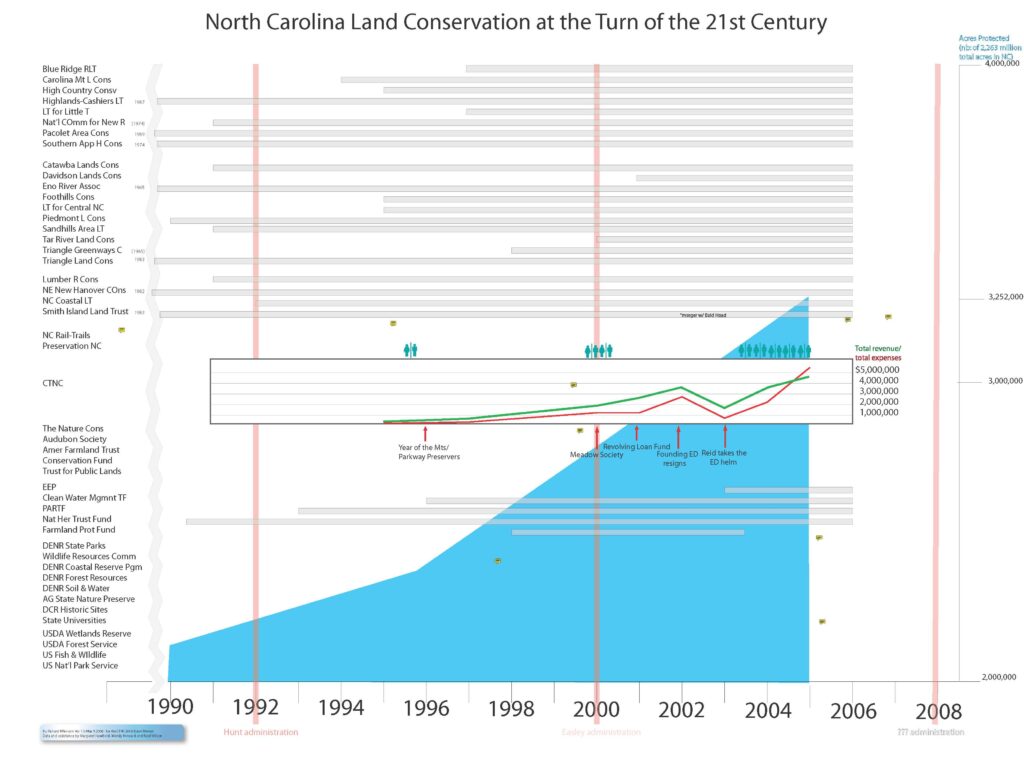North Carolina had a remarkable period of land conservation between the late 1980s and the early 2000s. For a nation that gets portrayed typically as single-mindedly obsessed with economic growth and (sadly, often tawdry) development, it’s worth reflecting on the accomplishments of those who have worked hard to keep unique natural places in the State protected. In particular, I want to single out the state’s land trusts, their funders and the private landowners they work with for their successes in the late twentieth century and beyond. In the year 2000, in the last administration of Gov. Jim Hunt, the State even committed to protection of an additional one million acres of permanently protected land by the year 2010–the so-called “Million Acres Initiative.”
The State of North Carolina shall encourage, facilitate, plan, coordinate, and support appropriate federal, State, local, and private land protection efforts so that an additional one million acres of farmland, open space, and conservation lands in the State are permanently protected by December 31, 2009. These lands shall be protected by acquisition in fee simple or by acquisition of perpetual conservation easements by public conservation organizations or by private entities that are organized to receive and administer lands for conservation purposes.”
S.L. 2000-23, codified at N.C. General Statutes § 113A-241 (emphasis added).
The idea of setting aside some lands for protection from development is surely an old idea that pre-dates the United States–for example, there were the royal forests of England dating from shortly after the Norman Conquest of 1066–but the creation of national and state parks is justly celebrated as an American innovation. North Carolina has its own great tradition of State parks, but the flowering of land conservation in the state represents a different tradition: a way of encouraging private landowners to voluntarily set aside land for environmental benefits.
The back story on the Million Acres Initiative, which I cannot confirm from personal observation, but which I believe to be true, is that Gov. Hunt was attending a dinner at a National Governors’ Association meeting and found himself sitting beside New Jersey Governor Christine Todd Whitman, who was shortly to become the Administrator of the U.S. Environmental Protection Agency in the first administration of President George W. Bush. As the story goes, Gov. Whitman, likely after hearing Gov. Hunt glowingly describe his beloved farm in the Rock Ridge community of Wilson County, said “you know Jim, in New Jersey we’ve committed to saving a million acres of land in the next decade. What are you doing in North Carolina?”
What we were doing in North Carolina is the subject of this graphic that I developed for a meeting of the state’s land trusts. It is a timeline that shows when the land trusts came into being and how much land they had protected as of 2006. The individual gray bars show the lifetimes of the state’s land trusts. The bigger bar in the middle shows the lifetime of the statewide land trust, the Conservation Trust for North Carolina, with a line graph of its budget (revenues in green, expenses in red). The blue shaded area in the background is my estimate of the acres of land permanently preserved in the State by the work of these land trusts, and others, up to the date of the report. Double click on the chart for a bigger graphic.

As far as I know, the State did not reach its goal of protecting one million acres by 2009. Since then, the debates over the value of State spending for land protection have become tense, and the State has greatly cut back its financial support, particularly through the Clean Water Management Trust Fund. Much of this tension is understandable in light of the severe recession starting in 2008; land protection seems like a luxury to anyone who has lost a job or otherwise has trouble putting food on the table.
But if you are one of those who doubts its value, I strongly suggest you go for a hike in one of the publicly accessible protected areas likely to be near you in North Carolina. If you can, try walking the nature trail in Joyce Kilmer Memorial Forest. You will see what a forest looked like that was spared the cutting that took out most of the virgin timber in North Carolina. And I bet you will be amazed, refreshed, and better suited for your return to the working world in the developed landscape of the rest of the State.
Land conservation is not just about wilderness for wilderness’ sake. It’s about holding onto to very unique places and habitats that make us more fully human, that enrich our lives in ways that commerce never will. Thank you to the many people across North Carolina who have helped make these special, protected places possible.
